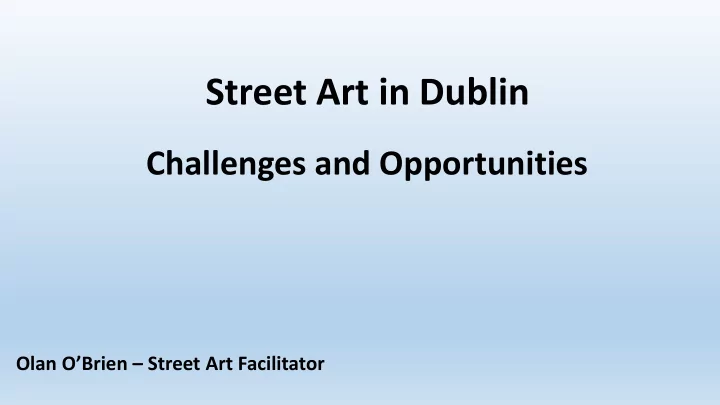

Street Art in Dublin Challenges and Opportunities Olan O’Brien – Street Art Facilitator
HISTORY OF STREET ART & GRAFFITI Graffiti emerged in New York in the early 70s. It was quasi legal for a period as the City couldn’t afford to clean the tags and pieces from the streets and trains that graffiti writers (as they became known) were painting. It emerged into public consciousness in the 80s after it got packaged with the emerging musical hip hop / breakdancing scene as one of the “Four Elements” alongside Hip Hop MCing (rapping), B Boying (Breakdancing,) & Dj-ing. Over the next 20 years the art form expanded from mainly letter based art form – a group of letters which formed a “tag” - alongside characters to include other forms of spraypaint art - often political statements, stencils, abstract forms of spraypaint art. This became known as “Street Art” popularized by Banksy. Broadly speaking - Graffiti was usually illegal, Street Art was more often commissioned by the owner of the space or a company for an advertisement PURPOSE OF PRESENTATION Outline the different forms of Graffiti – Street Art that we can see in Dublin Some of the problems facing the practitioners and the community at large with regards to it How the Council can help to encourage what is a popular participatory and extremely inclusive pastime for some, and living for others.
GRAFFITI PIECE “Pieces” usually consist of a “tag” which is the alias of the writer A background such as city scape etc which is the canvas for the letters A character or other illustrative additions Depending on the “style” it can be easy to read or hieroglyphic in its complexity!
WORLD CLASS GRAFFITI WRITER – HIGH LEVEL LETTER FORMS As this is a relatively new art form – in Ireland at least – there is not a great level of critical appreciation. All Graffiti / Street art is not the same – there are many different levels of skill! The two examples below are two pieces from Dublin’s Tivoli Theatre. They were painted by an artist called Rime. It may surprise you but both these pieces consist of an R , I , M and an E to make his tag.
GRAFFITI PRODUCTIONS – THEMED PIECES ON ONE WALL! Street artists & Graffiti writers often work in close collaboration – usually called Productions These would be a series of “pieces” usually colour themed with an extensive background Richmond St, Dublin 2 Sandyford, Co. Dublin Tivoli Theatre, Dublin 8
Tags & Throwups What people think of when they think Graffiti is often “tags” Illegal graffiti tags are usually quickly done with markers Throwups are quick illegal pieces usually done with paint
STREET ART – CHARACTERS / STATEMENTS Usually devoid of letters Street Art is probably more closely related to conventional art forms “Photo realistic” characters Playful colouring & comic style characters Readable simple slogans – such as Repeal 8 etc fall under this banner All these images below are taken from Tivoli Theatre, Dublin 8
COMMISSIONS / ADVERTISEMENTS Over the last few years there has been an explosion of advertisements & commissions Some are very obvious (see the Rolling Stones and Freddie Mercury below!) With others it’s not so obvious it’s an advertisement.
Less Obvious forms of Ads on walls in Dublin In the main this advertising is done by a very small number of artists and Advertising & Marketing agencies. This is very different to Productions & Pieces etc Problems Facing Graffiti – Street Art & Local Communities & Councils Lack of Legal Walls – A legal wall is an area – sometimes known as a “Hall of Fame” where anyone can paint regardless of level. Problem of Tagging Lack of Understanding of the wider Graffiti culture I’ve just outlined Planning Permission procedure How the Council Can Help Engage in dialog with Graffiti – Street Art Hobbyists as the dialogue is often regarding the commercial work. The Council can help provide legal areas to paint such as Richmond Lane, Dublin 2. Clear communication regarding Planning Permission procedure for the professional artist. What DCC are doing: Street Art Forum, Street Art Working Group. Partnership Planning Actions
Recommend
More recommend